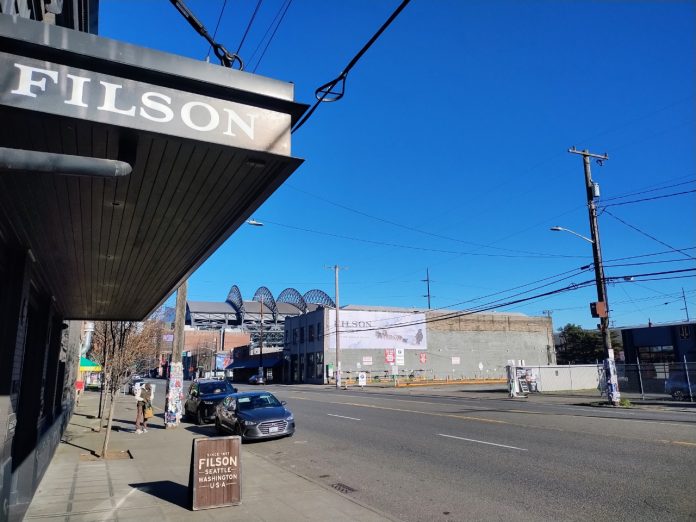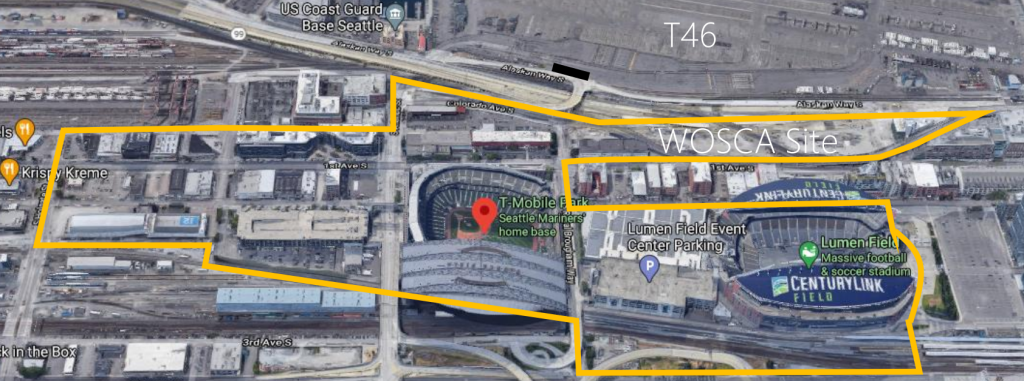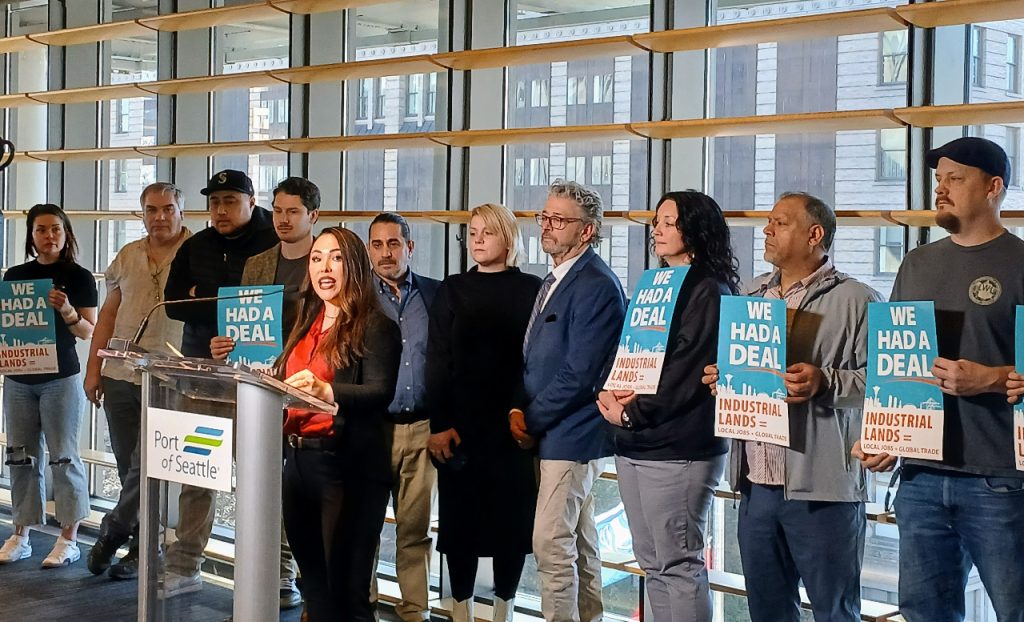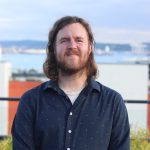
Seattle Council President Sara Nelson’s economic development committee voted 3-2 Thursday to recommend passage of a bill allowing housing in a small section of north SoDo near the city’s sports stadiums. The proposal has been strongly opposed by the Port of Seattle and other industrial and maritime groups. Council is considering the legislation separately from the city’s larger housing growth plan, which has been repeatedly delayed, faces a legal appeal from homeowner groups, and already blew past a state deadline.
Proponents of the idea, including the Seattle building trades, Pioneer Square neighborhood advocates, and stadium authority representatives, say that allowing housing above light industrial uses — creating a so-called Maker’s District — will increase the vibrancy of the area and help greater downtown thrive. They argue that the impact of additional residents in the area was already studied as part of a comprehensive environmental review three years ago and found to be insignificant. Nelson’s rezone would make room for about 1,000 homes, if built out to capacity.
But Port leaders paint that analysis as incomplete, alleging significant impacts to its operations that could come from new permanent residents on industrial land near busy freight terminals. Port of Seattle Commission President Toshiko Hasegawa, in a press conference ahead of Thursday’s vote, likened allowing housing in the stadium district to redlining, and warned of a slippery slope that could lead to the broader erosion of industrial areas. In recent days, the Port of Seattle has started to suggest they may take legal action to stop the move if it’s ultimately approved by the full council, expected as early as March 18.

The largest private landowner in the proposed SoDo housing district is California-based hedge fund manager Chris Hansen, who snatched up 14 acres near the stadiums nearly a decade ago in hopes of building an arena complex to one day host NHL hockey and NBA basketball games. However, Hansen’s plan relied on securing a street vacation from the City to host a multi-block development, which the Seattle City Council turned down in 2016 and instead advanced an alternate plan remodeling the publicly owned Seattle Center Arena. As a result, Hansen was left owning considerable SoDo land holdings and looking to build something other than an arena.
Critics have painted Nelson’s push as a giveaway to Hanson.
“This is more than an economic justice issue, this is about environmental and housing justice, and it’s a safety issue,” Hasegawa said. “It’s a carve-out for a specific property that would benefit a single out-of-state billionaire, undermining our collective goals for a healthy economy, environment, and quality of life for all of our residents. And it renegotiates a yearslong agreement between dozens of parties, for the benefit of a single party.”
In an op-ed last week in The Urbanist, Port Commissioner Ryan Calkins made the case for ensuring that industrial lands stay industrial, even as much of the stadium district remains dominated by non-industrial uses right now. “SoDo will be the place where greentech entrepreneurs can find industrial space well-suited to advanced manufacturing. Without industrial lands, those homegrown jobs will be lost to other markets,” Calkins wrote.
The area targeted by Nelson’s bill, officially called the Stadium Transition Area Overlay District (STAOD), is classified as Urban Industrial (UI) zone, a type of land use created in 2023 after a decade of debate over the future of Seattle’s industrial lands. Housing is allowed within UI zones in neighborhoods across the city like Georgetown, Interbay, and Ballard, but in the STAOD a prohibition on housing within 200 feet of a major truck street effectively keeps it banned, with First Avenue S, Royal Brougham Way, and Edgar Martinez Dr all highly used major truck streets that act as last-mile connections between port facilities on the waterfront and I-90.
Under city code, 50% of any housing allowed in the new UI zones must be made available to households making anywhere from 60% to 90% of King County’s area median income, or they must be completely live-work units or caretaker’s quarters. All residential units built in these zones have to have special windows built to handle additional air pollution and noise, and must be built with heavier-duty HVAC systems to improve air filtration.
Building owners also have to sign a special covenant that acknowledges future residents must “accept the industrial character of the neighborhood and agree that existing or permitted industrial uses do not constitute a nuisance or other inappropriate or unlawful use of land.”

Thursday’s committee vote saw Councilmember Joy Hollingsworth join with Bob Kettle, who has been clear from the outset that he opposes Nelson’s bill, in voting no. Hollingworth pointed to her family’s cannabis farm in Shelton, Washington, on the Olympic peninsula, as providing her direct experience with what it takes to get a product to market.
“The one thing that hit me is when I was talking to farmers from eastern Washington and they mentioned that, ‘Joy, getting through [Snoqualmie] pass is not hard for us, it’s navigating a Mariners game, or it’s navigating a Seahawks game’ and that potential impact of moving through SoDo and getting to the Port,” Hollingsworth said. “That’s what hit for me, the potential impact of adding more layers to that.”
Councilmember Dan Strauss has also voiced firm opposition to the proposal, which could make the full council vote razor-close.
Mark Solomon, who joined the council on January 27 to fill a vacancy left by the resignation of Tammy Morales, joined with Nelson and Maritza Rivera in voting to recommend the bill to the full council. Lamenting the divisiveness of this issue, Solomon suggested that there should be a way for the two opposing sides to come to an agreement, but didn’t offer any specifics on exactly how that would happen. For many freight and maritime advocates, the 2023 industrial lands legislation represents that agreement.

“We are looking at this as an either/or: either we build housing or we support the Port. I believe we can do both, I believe it’s a both/and,” Solomon said. “I’m still trying to wrap my brain around how doing a Maker’s District, doing housing in a small sliver [of SoDo] is going to have an impact on operations in and out of the Port. Because quite frankly, I think that the light rail expansion that’s going to happen in SoDo is probably going to have more of an adverse impact on freight mobility to and from the Port.”
Nelson, in response to the Port’s threat of legal action, suggested that the city would be spending additional time on legal analysis before putting the legislation to a final vote, but reiterated her support for moving forward with what she framed as a badly needed economic development tool.
“If I thought this was going to damage, irreparably, the Port or put it into a position, within a hundred years, where it would not be a strong viable entity I would not be doing this,” Nelson said. “If I thought it would significantly damage the industrial base south of city hall I wouldn’t be doing this.”
This article was made possible by the generous support of The Urbanist Fund. The Urbanist Fund is a 501(c)(3) organization that supports local, public-interest journalism. Visit theurbanistfund.org for more information or to make a tax-deductible gift.
Ryan Packer has been writing for The Urbanist since 2015, and currently reports full-time as Contributing Editor. Their beats are transportation, land use, public space, traffic safety, and obscure community meetings. Packer has also reported for other regional outlets including BikePortland, Seattle Met, and PubliCola. They live in the Capitol Hill neighborhood of Seattle.

